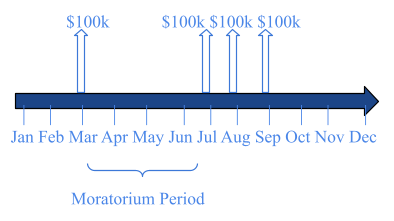Moratorium Period
The period when a borrower is not required to make payments for a specific time.
A moratorium period is when a borrower is not required to make payments. This period is standard when speaking about home loans and any educational loans. Although costs are not needed during this period, interest generally accrues.

These periods are only given as being justified. They have to be asked for a good reason, and the lender can approve the request and provide it to the borrower, or they can disapprove it. A moratorium is not guaranteed.
Many borrowers' reason for this period is due to financial hardships. This period allows individuals to have a couple of months to gather the funds before getting back to paying back the lender.
Moratoriums are given on numerous personal, home, credit cards, and educational loans. Educational loans are most common for this period because some students have a gap between graduation and obtaining a job.
Moratoriums are also common for home loans because after buying a house, individuals might need some time to get their financials in check before continuing to repay the loan.
The period generally starts after the loan is granted. This allows the borrower to have their finances sorted out for the repayment of the loan.

There are also instances when the moratorium period starts in the middle of the loan. Although the borrower is not making any payments during this period, interest is still accumulating.
Example
Maria was provided a $300,00 loan by her bank in February 2020 to help with her store. She had agreed to pay fixed monthly payments of $100,000 over four months, with a total repayment of $400,000.
However, in March 2020, due to the pandemic, Maria was forced to close her store. Since this was not planned, her bank granted her a moratorium period from March 2020 to July 2020, so she did not have to repay the loan during these months.
The diagram below shows what happened during Maria's repayment process after she was granted the moratorium:

So, instead of her last $100k payment being made in June, her previous cost got pushed back to October 2020.
Here is a real-world example of a moratorium:
In March 2020, the Reserve Bank of India (RBI) offered relief to loans, including educational, personal, and home loans. This lasted from March 1st, 2020, to August 31st, 2020.
In March 2020, the US set a federal student loan moratorium. It was made to help borrowers with economic hardship caused by COVID-19. You can find more information about it at this link.
The federal student loan moratorium is still present, as many individuals are hoping for a longer extension.
Moratorium Period vs. Grace Period
Many people need help understanding the difference between a grace period and a moratorium period, as it is easy to confuse them.

When a grace period occurs, interest does not build. This allows the borrower to make payments during this period before the payment is due. However, after the payment is due, interest builds.
A moratorium is different from a grace period in terms of interest. During this period, interest generally accrues. The borrower is also not required to make any payments during this time.
Another difference between these periods is the lengths. Moratoriums are generally longer than grace periods. Grace periods typically last 21 to 25 days, while moratoriums can last for months.
When a lender grants a grace period, that grace period is generally extended to all customers. This is different from a moratorium because it must be individually requested, and the lender has the power to approve or not allow a suspension.
Benefits and drawbacks
If you are considering asking for a moratorium, it is essential to know both the benefits and the drawbacks before deciding.

Benefits
- No impact on credit score: The moratorium does not negatively impact your credit score, so it does not affect the borrower's borrowing capacity.
- Good repayment plan: Moratoriums allow borrowers to make a better plan on how they will repay the loan. In addition, the time moratoriums give individuals can help them accumulate the funds needed to repay their loans.
Drawbacks
- No interest waiver: Although borrowers do not have to pay during moratoriums, interest is still accumulating. The accumulation of interest is the biggest drawback because moratoriums may lead to additional interest charges, resulting in more pressure on the borrower.
- Longer loan tenure: A break in the repayment schedule leads to increased loan tenure. This means if you had a repayment method set for you to pay the loan back within four years, it would now be longer than you scheduled.
A moratorium could be used for individuals who have a good plan. Borrowers usually use it with effective discipline because they will stick to the project they made when they asked for a moratorium.
Key Takeaways
- A moratorium period is when a borrower is not required to make payments for a specific time.
- A moratorium is not always guaranteed; they are given due to financial hardships so that the individual can have time to obtain the funds they need to repay the loan.
- Interest is still accumulating during the period.
- It does not impact the borrower's credit score.









or Want to Sign up with your social account?